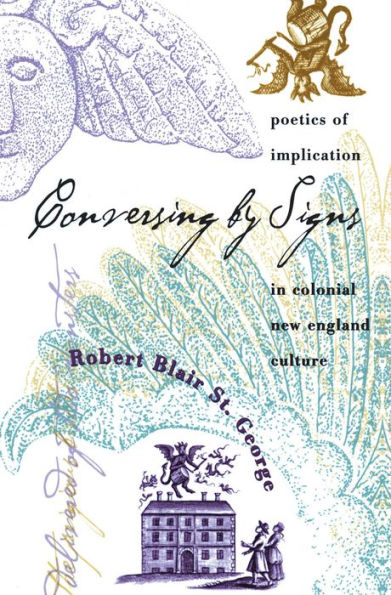Conversing by Signs: Poetics of Implication in Colonial New England Culture
The people of colonial New England lived in a densely metaphoric landscape—a world where familiars invaded bodies without warning, witches passed with ease through locked doors, and houses blew down in gusts of angry, providential wind. Meaning, Robert St. George argues, was layered, often indirect, and inextricably intertwined with memory, apprehension, and imagination. By exploring the linkages between such cultural expressions as seventeenth-century farmsteads, witchcraft narratives, eighteenth-century crowd violence, and popular portraits of New England Federalists, St. George demonstrates that in early New England, things mattered as much as words in the shaping of metaphor. These forms of cultural representation—architecture and gravestones, metaphysical poetry and sermons, popular religion and labor politics—are connected through what St. George calls a 'poetics of implication.' Words, objects, and actions, referentially interdependent, demonstrate the continued resilience and power of seventeenth-century popular culture throughout the eighteenth century. Illuminating their interconnectedness, St. George calls into question the actual impact of the so-called Enlightenment, suggesting just how long a shadow the colonial climate of fear and inner instability cast over the warm glow of the early national period.
1111445173
Conversing by Signs: Poetics of Implication in Colonial New England Culture
The people of colonial New England lived in a densely metaphoric landscape—a world where familiars invaded bodies without warning, witches passed with ease through locked doors, and houses blew down in gusts of angry, providential wind. Meaning, Robert St. George argues, was layered, often indirect, and inextricably intertwined with memory, apprehension, and imagination. By exploring the linkages between such cultural expressions as seventeenth-century farmsteads, witchcraft narratives, eighteenth-century crowd violence, and popular portraits of New England Federalists, St. George demonstrates that in early New England, things mattered as much as words in the shaping of metaphor. These forms of cultural representation—architecture and gravestones, metaphysical poetry and sermons, popular religion and labor politics—are connected through what St. George calls a 'poetics of implication.' Words, objects, and actions, referentially interdependent, demonstrate the continued resilience and power of seventeenth-century popular culture throughout the eighteenth century. Illuminating their interconnectedness, St. George calls into question the actual impact of the so-called Enlightenment, suggesting just how long a shadow the colonial climate of fear and inner instability cast over the warm glow of the early national period.
55.0
In Stock
5
1

Conversing by Signs: Poetics of Implication in Colonial New England Culture
480
Conversing by Signs: Poetics of Implication in Colonial New England Culture
480
55.0
In Stock

Product Details
| ISBN-13: | 9780807846889 |
|---|---|
| Publisher: | The University of North Carolina Press |
| Publication date: | 05/26/1998 |
| Edition description: | 1 |
| Pages: | 480 |
| Product dimensions: | 6.12(w) x 9.25(h) x 1.07(d) |
| Age Range: | 18 Years |
About the Author
What People are Saying About This
From the B&N Reads Blog
